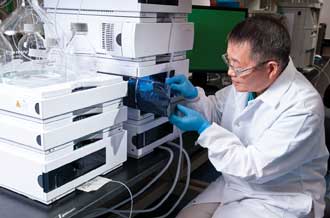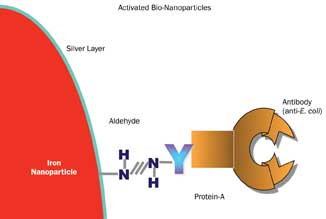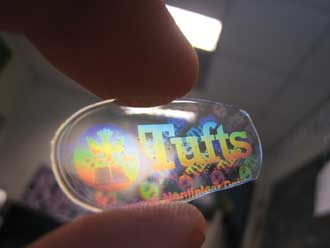Optics technologies are advancing food safety applications.
Natural pathogens. Food fraud and adulteration. Bioterrorism. Food safety is more of a concern today than it’s ever been before. Because the path from producer to consumer is long and complex – and often a bit of a mystery – it’s important to be able to tell what’s in our food. And new technologies are making it easier to do just that.
Thirty or 40 years ago, before the food industry became what it is today, a food fraud incident – where ingredients are substituted with others for economic gain – would likely have been confined to a small geographic area. Relatively few people would have been affected, and tracking the fraud to its source would have been relatively straightforward.

Food fraud is a growing concern worldwide. Cases like the melamine incidents of 2007 and 2008 – in which an industrial contaminant made its way into baby formula made in China – have spurred interest in developing and improving technologies for identifying such fraud. Here, a scientist with the US Pharmacopeial Convention is loading samples into the autosampler in a high-performance liquid chromatography system.
But now we have very long, complicated supply chains that “reach around the world and back,” said Jeffrey Moore, a researcher with the US Pharmacopeial Convention, a Rockville, Md.-based scientific nonprofit that sets standards for food ingredients, medicines and dietary supplements. This makes it especially difficult to monitor individual ingredients and detect cases of substitution or adulteration.
Food fraud is often viewed as an economic issue, but it also poses a growing health concern, in large part because of this globalization of the food supply. Ingredient tampering at any point in the food supply chain could have health consequences worldwide. And a single processed food product might have 10, 20 or even 30 different ingredients, increasing the likelihood of incidents and complicating efforts to identify and track them.
Researchers suggest that fraud might even be a greater health threat than other, more established food-related concerns. As an example, they point to the melamine incidents of 2007 and 2008, in which the industrial contaminant was found in some baby formula made in China, resulting in a number of illnesses among babies there. Melamine wasn’t on the food industry’s radar prior to the incidents, and for this reason, routine quality control analyses weren’t looking for it.
High-performance liquid chromatography and IR spectroscopy are among the analytical detection methods most commonly used in screening for food fraud. These are especially effective when testing simple chemical food additives – sodium benzoate, for example – where procedures are well established and relatively straightforward. When you start using complex ingredients such as milk powder or whey protein, Moore said – ingredients where the chemical composition can vary depending on the part of the world or breed of cow it’s from, etc. – “that’s where there are needs in terms of the technology.”
One of the ways to address these needs: rapid nontargeted analytical methods coupled with robust data analysis procedures, to handle the information-rich results from IR spectroscopy, and simply to determine whether the entire spectrum from a sample looks normal in comparison to a library of authentic spectra.
“When you’re analyzing something like milk powder that is compositionally complex and variable, you need sophisticated mathematical tools to make sense of the data,” Moore said. “Chemometrics” – the investigation of chemical systems via data analysis – “can distill these very complex data sets to help make a decision as to whether a test sample falls within the normal range of milk powders, or whether it looks suspicious and should be further tested.”
Implementation of these and other approaches would help to advance screening for food fraud by broadening the scope of what can be found. Many believe that the melamine issue could have been prevented if some of the technologies had been available before 2007, Moore said. Indeed, this realization has spurred interest in developing the technologies.
Detecting foodborne pathogens
This spring, a Buffalo, N.Y.-based snack food maker recalled more than 10 million pounds of frozen chicken quesadillas, pizza slices, Philly cheesesteaks and other items produced at its Waycross, Ga., plant, which had been linked to a potentially dangerous outbreak of E. coli. As of mid-May, 35 people in 19 states had fallen ill after eating the foods; nine had been hospitalized.

Researchers have reported a means of detecting E. coli using surface-enhanced Raman scattering and activated nanoparticles to identify small concentrations of the pathogen in milk and juice samples. Shown here is a schematic diagram of the bio-nanoparticle activation.
Foodborne pathogens such as E. coli, salmonella, cholera and others are a growing concern given their potentially significant health, economic and social impact. Especially because of the complex food supply chain in place today, we need technologies to identify such pathogens rapidly and reliably and to trace them back to their source.
Currently, officials use culture-based methods, immunology-based methods and polymerase chain reaction (PCR) to detect the unwanted pathogens. But even the fastest of these can take several hours to determine whether a pathogen is present.
Recently reported optical biosensors could help to address this limitation. Using Raman scattering, surface plasmon resonance and Fourier transform IR spectroscopy, researchers have demonstrated quick, sensitive detection of foodborne pathogens. In a 2010 Applied Biochemistry and Biotechnology paper, for example, a team at the Biotechnology Research Institute of the National Research Council Canada reported detection of E. coli using surface-enhanced Raman scattering (SERS) and activated silver nanoparticles.
In less than an hour, they were able to detect 103 cells per milliliter in milk and juice samples – without any pre-enrichment of the cells, which is “notoriously difficult and laborious,” said G. Melodie Naja, first author of the study and currently a water-quality scientist with the Everglades Foundation in Palmetto Bay, Fla.
Naja emphasizes the growing importance of speed, accuracy and simplicity in the detection of E. coli and other bacteria, especially with contamination threats on the rise. Here, she said, SERS can offer significant advantages over currently used microbiological tests, which typically call for highly trained personnel and lengthy detection times: four to six hours for PCR, for example, and up to 28 hours for enzyme-linked immunosorbent assay (ELISA).
Ultimately, Naja and others hope to see the technique applied for rapid on-site testing using portable devices. For this to happen, she said, further evaluation and optimization are still needed. Several groups – including teams at the University of Manchester in England and the University of Georgia – are working toward this goal.
Sensors you can eat
Researchers are also looking at other novel means of detecting foodborne pathogens. At Tufts University in Medford, Mass., for example, a team led by associate professor of biomedical engineering Fiorenzo Omenetto has described “edible sensors” that could be incorporated into, say, a bag of spinach to tell you whether the food is safe to eat.
The new class of sensors would combine nanoscale optics with biological readout functions. Food packagers could put a bioactive film in every bag of spinach, and this could provide a readout – via a color-changing hologram – of whether there is, for instance, E. coli bacteria in the bag. Importantly, the film is biocompatible and biodegradable. Consumers could eat it along with the spinach and not worry about any ill effects.
The sophisticated technology is based on what may seem an unlikely resource: silk. Using this ancient material, the researchers have shown they can combine the sensing and readout functions in a single biocompatible device. Silk can be processed into an ultrathin film, and a number of optical elements – microlens arrays, holograms – can be patterned into it. And because these elements are prepared, processed and optimized in all-aqueous environments and at ambient temperature, it is possible to integrate biological “receptors” – proteins and enzymes, for instance – that remain active for long periods even when stored at room temperature.

A group at Tufts University has developed silk-based optical sensors that are both biocompatible and biodegradable. This suggests a range of applications, including bioactive films that could be incorporated into food packaging to warn you of pathogens in its contents, for example.
These receptors can interact with their immediate environment – spinach, to return to our example – and report on it via the optical readout.
The researchers have more recently focused on possible biomedical applications of the silk-based devices – in a 2012 PNAS paper, “Implantable, multifunctional bioresorbable optics,” they describe a silk-based optical device with both imaging and therapeutic functions – but even this underscores the potential of the material for food-based applications, as the requirements of the technology are in many ways the same.
“Going from implantable to edible, the jump is not that far,” Omenetto said.
When olive oil isn’t olive oil
One of the most common forms of food adulteration is – surprisingly, perhaps – olive oil. Olive oil offers a range of health benefits – including lowered cholesterol – but when cut with other edible oils could lead to serious health concerns. There’s a significant need, then, to identify olive oil fraud.
In a 2013 issue of Laser Physics, T.M. Libish and colleagues report a means to detect adulteration in virgin olive oil using a fiber optic long-period-grating-based sensor. Based on changes in the long-period grating transmission intensity, the sensor could detect sunflower oil concentration with good linear sensitivity between 4 and 30 percent (sunflower oil is a common substitute in food fraud cases involving olive oil, typically in this concentration range).
The sensor is user-friendly and reusable, the researchers say, and it allows instantaneous measurement of the concentration of an adulterant with no need for chemical analysis; it works simply by immersing the sensor in a sample. Thus, it could prove very helpful in detecting adulteration of olive oil and other foods.